Source: Prisoner Taking and Human Sacrifice by the Moche of Ancient Peru

Selected by John Verano. From John Verano, “Warfare and Captive Sacrifice in the Moche Culture: The Battle Continues,” in Embattled Bodies, Embattled Places: War in Pre-Columbian Mesoamerica and the Andes, ed. Andrew Scherer and John W. Verano (Washington D.C.: Dumbarton Oaks Pre-Columbian Symposia and Colloquia, 2014), 283-310.
Verano, “Warfare and Captive Sacrifice,” 283.
Until 1995, the sacrifice of captives by the Moche was known only from depictions in Moche art. With the exception of indirect evidence such as weapons found in tombs and depictions of armed combat and the taking of captives, there was little physical evidence of such activities in the archaeological record. This was in contrast to offerings of human lives in funerary contexts (retainer burials accompanying high status individuals), which had been documented archaeologically as early as 1946 in the Virú Valley in the Tomb of the Warrior Priest, and subsequently at various north coast sites. While the archaeological evidence of captive sacrifice by the Moche is now unequivocal, debate continues over the context in which captives were taken (warfare or ritual combat), the source of captives (locals or outsiders), and larger issues such as the ritual and political significance of prisoner capture and sacrifice in Moche society.
Discussion Questions
- How do we know which of the four warrior figures in the line drawing are the captors and which are the captives? List three distinguishing features of the captives.
- Compare this drawing with the other depictions of captive warriors listed below. One comes from the same culture, the Moche, while the rest come from different cultures. What do all of these depictions have in common? What is distinctive to the Moche depictions?
Related Primary Sources
- Two Moche ceramic pots depicting captive warriors: https://medievalslavery.org/4th-century/ and https://medievalslavery.org/south-america/
- An Aztec depiction of captive warriors: https://medievalslavery.org/mesoamerica/
- A Mayan depiction of captive warriors: https://medievalslavery.org/8th-century/
- A Byzantine depiction of captive warriors: https://medievalslavery.org/11th-century/
- A Cambodian depiction of captive warriors: https://medievalslavery.org/east-asia-and-pacific/
Related Secondary Sources
- Donnan, Christopher B. “Moche State Religion.” In New Perspectives on Moche Political Organization, ed. Jeffrey Quilter and Luis Jaime Castillo, 47–69. Washington, D.C.: Dumbarton Oaks Research Library and Collection, 2010.
- Quilter, Jeffrey. “Moche Politics, Religion, and Warfare.” Journal of World Prehistory 16, no. 2 (2002): 145–195.
- Verano, John W. “Warfare and Captive Sacrifice in the Moche Culture: The Battle Continues.” In Embattled Bodies, Embattled Places: War in Pre-Columbian Mesoamerica and the Andes, ed. Andrew Scherer and John W. Verano, 283-310. Washington D.C.: Dumbarton Oaks Pre-Columbian Symposia and Colloquia, 2014.
- Verano, John W., and Sara S. Phillips. “The Killing of Captives on the North Coast of Peru in Pre-Hispanic Times: Iconographic and Bioarchaeological Evidence.” In Ritual Violence in the Ancient Andes: Reconstructing Sacrifice on the North Coast of Peru, ed. Haagen D. Klaus and J. Marla Toyne, 244-265. Austin: University of Texas Press, 2016.
